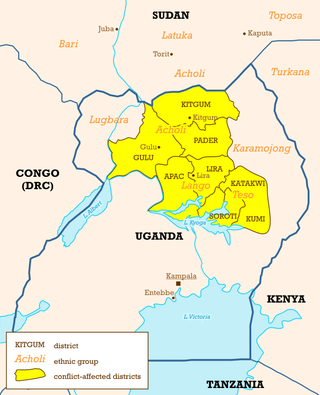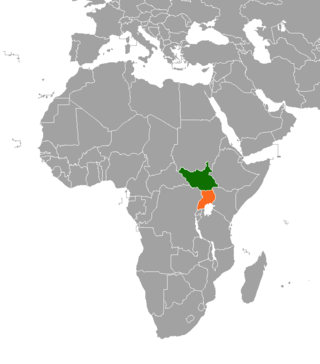
The Lord's Resistance Army insurgency is an insurgency by the Lord's Resistance Army against the government of Uganda. After the Ugandan Civil War, Ugandan militant Joseph Kony formed the Lord's Resistance Army and waged an insurgency against the newly-installed president Yoweri Museveni. The stated goal was to establish a Christian state based on the Ten Commandments. Currently, there is low-level LRA activity in the eastern Democratic Republic of the Congo and the Central African Republic. Kony proclaims himself the "spokesperson" of God and a spirit medium.
Joseph Rao Kony is a Ugandan militant and warlord who founded the Lord's Resistance Army (LRA), designated as a terrorist group by the United Nations Peacekeepers, the European Union, and various other governments.
The period from 2000 to 2006 of the Lord's Resistance Army insurgency in northern Uganda begins with the assault of the Uganda People's Defence Force (UPDF) upon LRA strongholds in South Sudan. This in turn led to a series of retaliatory attacks by the Lord's Resistance Army of an intensity not seen to since the mid-1990s. International awareness of the conflict gradually grew and in September 2005, the International Criminal Court issues warrants for the arrest of senior LRA commanders, including Joseph Kony.
Vincent Otti was a Ugandan militant who served as deputy-leader of the Lord's Resistance Army (LRA), a rebel guerrilla army operating mainly in northern Uganda and southern Sudan. He was one of the five persons for whom the International Criminal Court (ICC) issued its first arrest warrants on 8 July 2005 in its investigation in Uganda. Rumours of his death began to circulate in October 2007 and strengthened in January 2008. On 17 November 2023, the ICC terminated proceedings against him.
Dominic Ongwen is a Ugandan former child soldier and former commander of one of the brigades of the Ugandan guerrilla group Lord's Resistance Army (LRA).
The Aboke abductions were the kidnapping of 139 secondary school female students from St. Mary's College Secondary school by rebels of the Lord's Resistance Army (LRA) on 10 October 1996, in Aboke, Kole District, Uganda. The deputy head mistress of the college, Sister Rachele Fassera of Italy, pursued the rebels and successfully negotiated the release of 109 of the girls. The Aboke abductions and Fassera's dramatic actions drew international attention, unprecedented at that time, to the insurgency in northern Uganda. A book titled "Aboke Girls" was written by Els De Temmerman about the abductions and effects of the abductions.

The Juba talks were a series of negotiations between the government of Uganda and the Lord's Resistance Army rebel group over the terms of a ceasefire and possible peace agreement. The talks, held in Juba, the capital of autonomous Southern Sudan, began in July 2006 and were mediated by Riek Machar, the Vice President of Southern Sudan. The talks, which had resulted in a ceasefire by September 2006, were described as the best chance ever for a negotiated settlement to the 20-year-old war. However, LRA leader Joseph Kony refused to sign the peace agreement in April 2008. Two months later, the LRA carried out an attack on a Southern Sudanese town, prompting the Government of Southern Sudan to officially withdraw from their mediation role.
Amuria is a town in the Eastern Region of Uganda. It is the chief municipal, administrative, and commercial center of Amuria District, in the Teso sub-region.
The Uganda People's Army (UPA) was a rebel group recruited primarily from the Iteso people of Uganda that was active between 1987 and 1992. The UPA was composed mostly of former soldiers in the special forces of the Uganda National Liberation Army and opposed the National Resistance Army (NRA) government of Yoweri Museveni, who took power in January 1986. Reaching a height after the widespread cattle raid by Karamojong in 1987, the UPA rebellion was eventually ended through the mediation of the Teso Commission.

The Lord's Resistance Army (LRA) is a Christian extremist organization operating in Central Africa and East Africa. Its origins were in the Ugandan insurgency (1986–1994) against President Yoweri Museveni during which Joseph Rao Kony founded the LRA in 1987.

The 2008 Christmas massacres were a series of attacks in several villages in Haut-Uele District, DR Congo by the Lord's Resistance Army (LRA) on 24–27 December 2008
Musa Francis Ecweru, is an accountant and politician in Uganda, the third-largest economy in the East African Community. He is the current Minister of State for Works and Transport (Works) in the Ugandan Cabinet where he previously served as the State Minister for Relief and Disaster Preparedness since 1 June 2006 In the cabinet reshuffles of 16 February 2009, 27 May 2011, and 2016. He is also the elected Member of Parliament (MP), representing Amuria County, Amuria District since 2006.

South Sudan and Uganda are neighboring states with strong cultural economic and political ties. The South Sudan and the neighbouring state of Uganda enjoy relatively strong cultural, political, and economic ties. As South Sudan neared independence, both states begun to take advantage of increased opportunities for trade, development and educational exchanges. The rebel group Lord's Resistance Army (LRA), however, continues to operate in the border areas between South Sudan, the Democratic Republic of Congo and Uganda.
The Arrow Boys are a militia operating in the Western Equatoria region of South Sudan. The militia sprung up as a self-defense unit who get their name from their use of bows and arrows supposedly treated with poison, and other traditional weapons.
The Regional Cooperation Initiative for the elimination of the LRA (RCI-LRA) with its military arm, the African Union Regional Task Force was a multi-national operation to counter the Lord's Resistance Army (LRA). On 22 November 2011 the AU Peace and Security Council authorized the RCI-LRA with the mandate to "strengthen the operational capabilities of the countries affected by the atrocities of the LRA, create an environment conducive to the stabilization of the affected areas, free of LRA atrocities, and facilitate the delivery of humanitarian aid to affected areas." The United Nations provided logistical support, the European Union and African Union contributed additional funding, and the United States provided non-combat military and strategic support.
Susan Amero is a female Ugandan member of parliament for the Amuria district, she is a member of the ruling National Resistance Movement political party

From 1986 to 1994, a variety of rebel groups waged a civil war against the Ugandan government of President Yoweri Museveni. Most of the fighting took place in the country's north and east, although the western and central regions were also affected. The most important insurgent factions were the Uganda People's Democratic Army (UPDA), the Uganda People's Army (UPA), Alice Auma's Holy Spirit Movement (HSM), and Joseph Kony's army. Several smaller rebel factions and splinter groups of the larger movements waged their own campaigns; the rebels often clashed with each other. All belligerents, including the government, targeted civilians and committed human rights violations. In course of fighting that involved tens of thousands of troops, the Ugandan government was able to gradually defeat or contain most rebel factions. The operations in the north and east caused great destruction and resulted in high civilian casualties.
On 16 June 2023 rebels of the Allied Democratic Forces (ADF), a jihadist group speculatively linked by analysts to the Islamic State, attacked a secondary school in Mpondwe, a town in western Uganda's Kasese District on the border with the Democratic Republic of the Congo. 42 people were killed, including 38 students; 8 were injured.
The Barlonyo Memorial Site is also known as Barlonyo Monument or Barlonyo Massacre site is a mass grave where the 301 civilian who were massacred by the Lord Resistance Army on 2004-02-21 were buried. The monument was raised in memory of the people who were man slaughtered.
Mukura Memorial is also called Mukura mass grave or Mukura monument is a mass grave where the victims of the 1989 Mukura killings where buried. It has names of the people who were killed inscribed.






